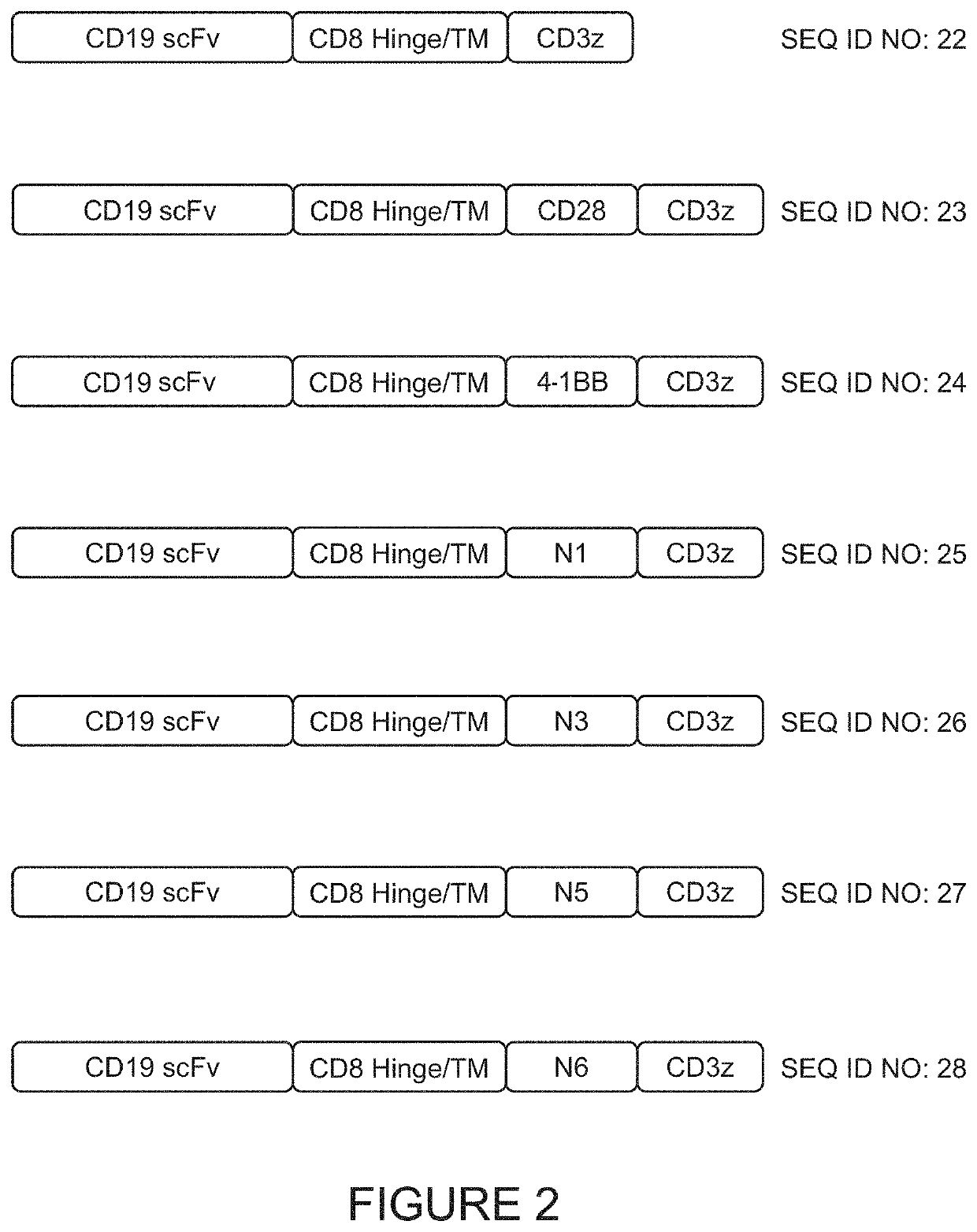Co-stimulatory domains for use in genetically-modified cells
a technology of co-stimulatory domains and genetically modified cells, which is applied in the field of molecular biology and recombinant nucleic acid technology, can solve the problems of inability to direct antigen-induced expansion of modified primary t cells, no domains of the present disclosure have been disclosed, and cell anergy, etc., to promote promote different degrees of cell proliferation and/or cytokine secretion
- Summary
- Abstract
- Description
- Claims
- Application Information
AI Technical Summary
Benefits of technology
Problems solved by technology
Method used
Image
Examples
example 1
Production of Lentiviral Vectors for Expression of CARs with Novel Co-stimulatory Domains
[0223]The purpose of this study was to evaluate and characterize novel co-stimulatory domains that were developed to promote CAR-T cell expansion and cytokine secretion following antigen stimulation.
[0224]As shown in FIG. 1, four novel co-stimulatory domains were engineered which comprise two TRAF-binding motifs. These domains are referred to as Novel1 (N1: SEQ ID NO: 5), Novel3 (N3; SEQ ID NO: 6). Novel5 (N5; SEQ ID NO: 7), and Novel6 (N6; SEQ ID NO: 8). In order to evaluate each novel co-stimulatory domain, lentiviral vectors were used to prepare anti-CD19 CAR-T cells. Each CAR comprised, from 5′ to 3′, a signal peptide (SEQ ID NO: 16), an anti-CD19 scFv (SEQ ID NO: 17) having the heavy chain and light chain variable regions of the FMC63 antibody linked by a (G4S)3 polypeptide linker, a CD8 hinge region and transmembrane domain (SEQ ID NO: 18), and an intracellular region comprising two intrac...
example 2
Expression of Chimeric Antigen Receptors Comprising Novel Co-stimulatory Domains in Human T Cells and Characterization in Antigen-induced Stress Test
[0226]1. Preparation of CAR-T Cells and Antigen-induced Stress Test
[0227]The purpose of this study was to evaluate the novel co-stimulatory domains in an antigen-induced stress. Briefly, lentiviral vectors were prepared as described in Example 1. To prepare donor human T cells for lentiviral transduction. T cells were stimulated in ImmunoCult anti-CD2 / CD3 / CD28 multimers (StemCell Technologies) and 20 ng / ml of IL-2 for 4 days. Cells were then collected and deposited into separate wells for transduction with individual lentiviral vectors. 5 Transducible Units per T cell were added to cultures. Transduction was performed in X-VIVO 15 medium (Lonza) supplemented with only IL-2 (20 ng / ml) and 8 μg / ml of polybrene (Sigma). Co-incubation of vector and T cells was carried out overnight prior to medium replacement (X-Vivo 15+20 ng / ml IL-2+5% nor...
experiment # 1
2. Results of Experiment #1
[0232]CAR-T cell numbers were measured over time and plotted in FIG. 4. Differences in CAR-T numbers were evident from d10 onward. CAR-T cells with 41BBz signaling domains exhibited more sustained proliferation than those with CD28z domains. The BB null control exhibited the lowest levels of CAR-T expansion in this experiment. Novel domains N5 and N6 exhibited high levels of sustained proliferation. No preference for CD4 (FIG. 4B) or CD8 (FIG. 4C) T cell expansion was observed, as each subset proliferated at similar rates. In order of descending performance in this proliferation assay, the results are as follows: N6>N5>41BBz>N1>>BBnull=CD28z>N3
[0233]Secretion of IFNγ, TNFα, and IL-2 were measured by Luminex multiplex assay and appear in FIGS. 5A, 5B, and 5C, respectively. In general, secretion levels of all cytokines decreased over time. Ranking of the domains in terms of IFNγ reaction at d3 is as follows: 41BBz=CD28z>N1>N5>BBnull=N3>N6. Levels of IFNγ dec...
PUM
| Property | Measurement | Unit |
|---|---|---|
| length scale | aaaaa | aaaaa |
| length scale | aaaaa | aaaaa |
| nucleic acid | aaaaa | aaaaa |
Abstract
Description
Claims
Application Information
 Login to View More
Login to View More - R&D
- Intellectual Property
- Life Sciences
- Materials
- Tech Scout
- Unparalleled Data Quality
- Higher Quality Content
- 60% Fewer Hallucinations
Browse by: Latest US Patents, China's latest patents, Technical Efficacy Thesaurus, Application Domain, Technology Topic, Popular Technical Reports.
© 2025 PatSnap. All rights reserved.Legal|Privacy policy|Modern Slavery Act Transparency Statement|Sitemap|About US| Contact US: help@patsnap.com



